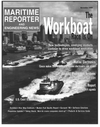
Page 81: of Maritime Reporter Magazine (November 1999)
Read this page in Pdf, Flash or Html5 edition of November 1999 Maritime Reporter Magazine
form 14 operational mis-sions in the areas of maritime safety, law enforcement, environmental pro-tection, and national ^F defense. The Project's innovative approach affords several H^^r compelling advantages. By encompassing all of the USCG's ^T Deepwater assets, the Project is able to determine the most effective types and efficient mix of assets. The focus on performance capabilities empowers industry to leverage innova-tive new technologies and processes. Acquiring an integrated system of assets builds-in interoperability right from the start. Cohesive interoperability affords seamless coordinated perfor-mance of missions by multiple assets that produces an overall force multiplier effect. Global Trends ? Future Threats In the 21st century, demand for USCG services is projected to increase. Stud-ies by the Office of Naval Intelligence and others foresee global events ? such as the doubling world population, the continued decline in marine fisheries, the end of the cold war, and the tripling of international commerce ? greatly increasing the nation's reliance on the USCG. As a result, the USCG can expect increased emphasis on the protection of the environment and living marine resources. Illegal immigration and drug smuggling will continue to be service priorities. The requirement to perform international operations either individu-ally or jointly with other armed forces will increase. Overall, the USCG can anticipate a greater role as a unique instrument of national security. Always Ready? While the USCG stands "Semper Paratus," always ready, to face the many challenges of its deep water missions, the greatest threat confronting the ser-vice is that its deep water cutters and air-craft are aging and technologically obsolete. As a result, these platforms have excessive operating and mainte-nance costs and lack essential capabili-ties in speed, sensors, and interoperabil-ity that limit overall deep water mission effectiveness and efficiency. Project Acquisition Strategy The Deepwater Project is the USCG's answer to increasing service demands and pressing recapitalization needs. The Project is currently in Phase 1 Concept Exploration. Selected industry teams are researching and engineering their integrated Deepwater system concepts. November, 1999 Phase 1 began last August with the award of Conceptual Design contracts to three industry teams - Lockheed Mar-tin, Avondale Industries Inc., and Sci-ence Applications International Corp. serving as prime contractors. The chart at the bottom of the previous page pro-vides a complete list of Deepwater industry team participants. As noted on the Project schedule, an independent USCG Roles and Missions Study are underway. This group is examining and may recommend changes to the current slate of overall USCG responsibilities. The Study's findings will be incorporated into indus-try's integrated Deepwater system designs. During Phase 2, industry teams will develop final cost and technical propos-als for their integrated Deepwater sys-tem concepts. Contract award to one team for the construction and imple-mentation of the Integrated Deepwater System is scheduled for January 2002. For further information on the Deepwater Project, log onto www. uscg. mil/deepwater Introducing /The SmartHook® Automatic Load Monitoring Automatically displays mooring line tension locally at each hook No operator intervention required Allows mooring crew to pre-tension lines Alarms at each hook warn of high loads Records average and peak loads and mooring history No additional site wiring required Can be retrofitted to existing hooks Suitable for Class I Div I hazardous areas For more information visit our web site or contact us at: Harbour & Marine Engineering PTY LTD Head Office USA Office 79 Asling St. Brighton, Melbourne, Australia. 3186. Contact Mr D Grothe Phone: +61 3 9530 6333 Tel: + 1 303 779 4905 Fax: + 61 3 9530 6366. Fax: + 1 303 721 9310 Email: [email protected] Email: [email protected] Web: http://www.harbourmarine.com Circle 330 on Reader Service Card Smart Strain Gauge Level Sensor with Generic 4~20mA Output Use one sensor for all shipboard liquid levels This technology has been designed specifically for surviving the rigors of ballast tank continuous monitoring. It weighs less than 2 oz. and is con-structed from 100% pure titanium. ? It's the size of your thumb ? Accuracy .25% of full scale ? 100% Titanium ? Weighs less than 2 oz. ? ABS/USCG/Uoyds approved ? FM Class 1, Div. 1 Intrinsically Safe ? Removal without tank entry ? No mercury or other contaminants ? Interfaces to your existing monitoring system ? One sensor for all shipboard liquids: fuel oil, lube oil, fresh water, black water, etc. ? Generic 4-20 mA output ? Used iri 15,000 tanks worldwide Many Options Call today for more information! ELECTRONIC MARINE SYSTEMS, INC. 800 Ferndale Place Rahway, NJ 07065 732.382.4344 732.388.5111 fax [email protected] e-mail http://www.emsmarcon.com Circle 244 on Reader Service Card 77 LOAD AVERAGE PEAK LOADS IN TONNES THE BALLAST

 80
80

 82
82
